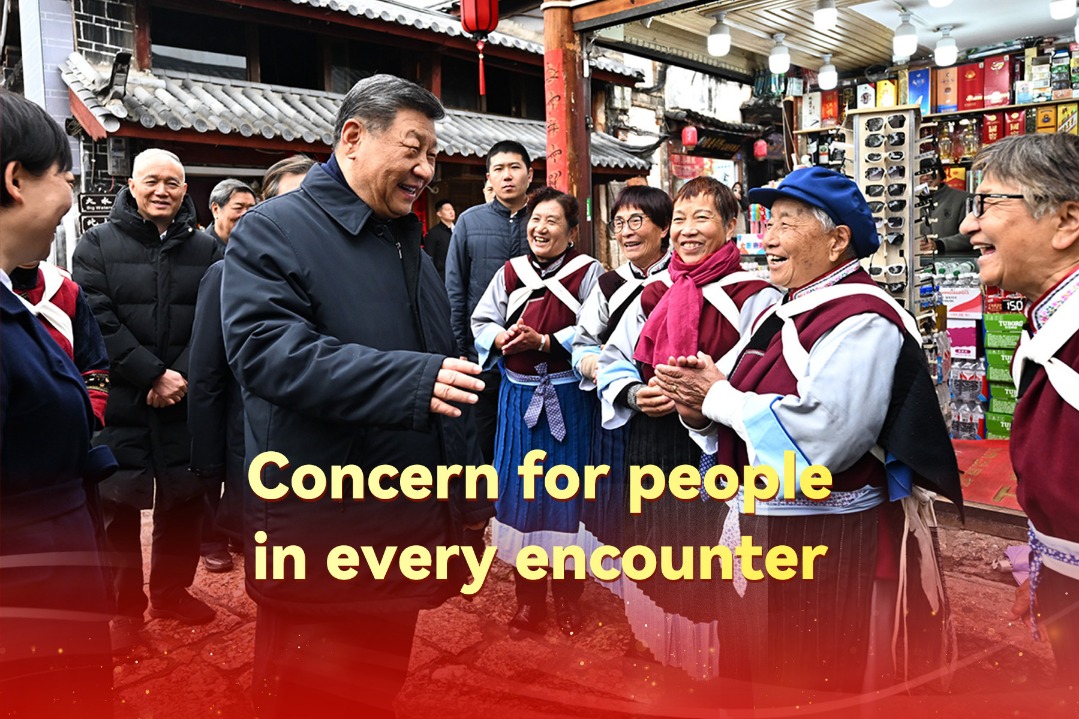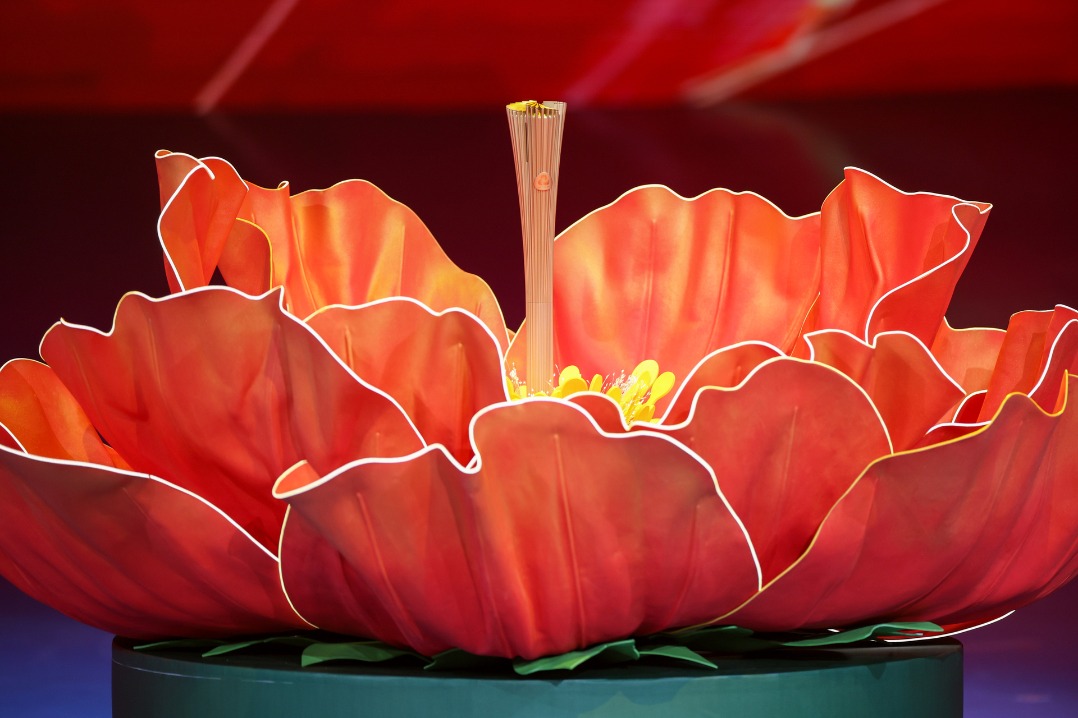Pipa player breathes new life into ancient Dunhuang scores
After deep research into decoded music pieces, Wu Man releases album in hope of preserving ancient tunes, Chen Nan reports.

With the delicate touch of her fingers, Wu Man carefully unravels the threads of a distant past.
When the internationally celebrated pipa (a four-stringed Chinese lute) virtuoso took the stage at the National Centre for the Performing Arts in Beijing on Dec 3, she performed music pieces based on ancient scores from the Mogao Caves, a UNESCO World Heritage Site in Dunhuang, Gansu province, transcending the boundaries of time and space.
With the pipa, Wu doesn't just re-create history — she channels it, breathing life into ancient melodies preserved in the cave walls for over a millennium.
On the same day, Wu announced the release of her new album Music From the Dunhuang Caves, released under NCPA Classics.
The album draws upon various scholarly translations of the 25 Dunhuang pipa scores, particularly the work of Chen Yingshi, along with contributions from prominent scholars such as Ye Dong and Xi Zhenguan. Wu's rendition not only stays true to these interpretations but also integrates her unique artistic expression, breathing new life into the ancient music.
The album also includes seven improvisational pipa solos inspired by the Dunhuang scores, showcasing Wu's ability to blend tradition with contemporary sensibilities.
Dunhuang, in northwest China's Gansu province, is known for the Mogao Caves, which house the finest Buddha art in China dating back to the 4th century. It was a key stop on the Silk Road in the past.
The discovery of the 25 pipa scores in the Mogao Caves is part of the historical findings of a vast collection of ancient manuscripts, paintings and artifacts uncovered in 1900 in the famous Library Cave, or Cave 17.
According to musicologist Xia Yanzhou from the Zhejiang Conservatory of Music, these scores represent some of the oldest known surviving examples of "written music for the pipa", one of China's most iconic traditional instruments. The music dates back to the Tang Dynasty (618-907), a period that was considered the golden age of Chinese culture, including its music.
Xia also notes that the notations used for pipa music were different from the modern system. The scores were written in "graphical notation" form, often using symbols or calligraphic marks that indicated how the instrument should be played. Decoding these ancient pieces requires a deep understanding of traditional Chinese musical theory and the historical context of the time.
According to Wu, the idea of recording the album started in 2021 when she was invited to join a documentary about Dunhuang.
"When I visited the Mogao Caves in Dunhuang, where the ancient pipa manuscripts were discovered, I was like a child full of curiosity. I was deeply moved when I saw the historical site," she recalls. "I felt a strong responsibility to preserve and bring attention to this invaluable cultural heritage. This experience laid the foundation for this album, which is not just a performance of ancient music but a personal and artistic journey that seeks to reconcile the ancient with the contemporary.
"For me, the pipa is an integral part of my life and this album feels like a vital chapter in my artistic career. It is also a significant step in preserving pipa art," she notes, adding that the album took her three years to complete and was a deeply personal endeavor.
International acclaim
A child prodigy who began learning at 9, Wu, born in Hangzhou, Zhejiang province, was accepted into the conservatory at 13 and became the first recipient of a master's degree in pipa in the country.
Known for its distinctive pear-shaped body, the pipa typically has four strings and is played either with the fingers or a plectrum. It is known for its versatility and expressive range and is capable of producing both melodious and percussive sounds, playing a significant role in Chinese musical heritage.
Wu, who lives in California, is considered an ambassador for the pipa and has brought the instrument international acclaim.
Wu recalls that, as early as the 1980s during her student days, she was aware of these valuable Dunhuang pipa scores, which received worldwide attention and attracted many experts to decode. As a student, she was curious about the notation and musical sound of the Dunhuang pipa scores, how they were deciphered and what the music sounded like.
"I have explored pipa ensemble performances, blending Chinese and Western elements through collaborations with string quartets and pipa concertos. Given the pipa's profound impact on my life, performing the Dunhuang scores has become an essential goal in my artistic journey. It is a long-held aspiration that I must fulfill," she says. "I believe that the history of the pipa and its music represents Chinese history, particularly the evolution of Chinese music.
"It is a process of cultural development. Traveling along the Silk Road from Central Asia, it's interesting because you'll find that the Dunhuang pipa scores sound like a mixed style," she continues. "Over the years, I have collaborated with Central Asian musicians and worked extensively with European musicians. These experiences have enriched my musical vocabulary and informed my approach to the Dunhuang pipa scores."
Exploring interpretations
For this album, Wu chose different versions of translated scores to fill a significant void in pipa performance history.
"While numerous Dunhuang pipa score translations exist, their musical interpretations remain largely unexplored. Existing orchestral performances of the scores do not fully capture the essence of the solo pieces. I intend to record all 25 Dunhuang pipa scores on a single pipa, inviting listeners to experience and imagine their sound," she says.
Performing ancient scores is undoubtedly complex, demanding a delicate balance between honoring the original scores and the performer's interpretive abilities. Wu strives to adhere to the rhythmic indications provided by the scholars with the constraints of the pipa and her own understanding. For instance, differentiating between the piece Ji Quzi (fast composition) and the piece Man Quzi (slow composition) is clear, but determining precise tempos remains elusive due to the absence of explicit tempo markings in the scores or translator guidelines.
"The people who wrote the scores left space for the pipa players to use imagination. The tempo, for instance, is determined by the player through personal experience, intuition and imagination," says Wu.
"Each generation has its own 'decoding' and no single version can be considered exactly what it was in the scores. Therefore, there will always be discoveries and new understandings in transcription and performance."
With its deep scholarly research, stunning performances and imaginative improvisations, Wu's album represents a significant contribution to the world of classical Chinese music.
"This album takes the listeners on a powerful journey through time, as well as a dialogue between ancient and contemporary music. It is a tribute to the enduring legacy of Dunhuang's musical heritage," says Zhang Meng, deputy editor-in-chief of People's Music magazine. "Its release is a timely reminder of the rich cultural history that we must preserve and innovate for future generations, all while continuing to honor the traditions that have shaped our artistic identities."


Today's Top News
- Chengdu gearing up for World Games
- China, Nepal to strengthen bilateral ties
- Schoolgirl swimmer shines at worlds
- Interest in vocational programs surges
- Robust policy support to propel growth
- US putting its old-generation chips on Chinese table in a bid to stop Ascend































